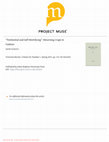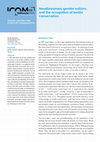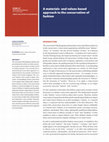Papers by Sarah Scaturro, PhD

For the People: Renewing Conservation Ethics for Dress Collections
Dress, 2024
The conservation field has recently experienced a significant paradigm shift called “peoples-base... more The conservation field has recently experienced a significant paradigm shift called “peoples-based” conservation, which centers collaboration with communities for whom cultural heritage has meaning. This turn is so significant that it has the possibility of upending core preservation practices of dress museology, and yet, few dress studies professionals might be aware that this shift has even occurred, or that it has a name. This article describes the transformative move in conservation ethics towards peoples-based approaches and points to potential impacts this shift might have on the preservation of dress artifacts. One specific fashion museological practice—the prohibition against the wearing of historic dress—is explored as an example of how this shift towards peoples-based conservation approaches opens exciting opportunities for dress professionals, empowering them to consider how collaborative preservation and interpretive strategies might sustain and even enhance the meaning of collection objects.

Victorian Review, 2023
In 2014, while preparing for the fashion exhibition “Death Becomes
Her: A Century of Mourning Att... more In 2014, while preparing for the fashion exhibition “Death Becomes
Her: A Century of Mourning Attire” organized by the Costume
Institute (CI) at the Metropolitan Museum of Art, the author, who was
then the CI’s head conservator, encountered a question. Was the material
being displayed toxic? This question arose upon discovering that
nineteenth-century periodicals cautioned against wearing mourning
crape, which is a crispy, crinkled, and dull black silk fabric worn in the
first stages of Victorian mourning. According to these sources, mourning
crape was poisonous. Seeking answers, the author would soon
find out that, indeed, there was something to those warnings after
all. In fact, an investigation into Victorian mourning crape reveals the
incongruous story of a wretched and dangerous fabric that rose to the
height of luxurious fashion. This article recounts this tale by exploring
the history and materiality of English mourning crape to provide
insight into both the macabre meaning of the fabric and the dreadful
experience of wearing it.

Working Towards a Sustainable Past. ICOM-CC 20th Triennial Conference Preprints, Valencia, 18–22 September 2023, 2023
In 1985, Inger Marie von der Lippe published her dissertation on the working conditions of textil... more In 1985, Inger Marie von der Lippe published her dissertation on the working conditions of textile conservators, primarily in Scandinavia. Her ethnological study, Profession or occupational culture? claimed that textile conservation was an occupational culture grounded in bourgeois feminine pursuits of needlework and volunteerism. The low wages, unstable employment, and dearth of education and respect were stifling the field's development from an occupation into a profession. Von der Lippe's study was groundbreaking, but the importance of her findings has not been examined within the history of conservation. This paper contextualizes her work within textile conservation's history in North America and Europe, by investigating two aspects that hindered the development of the field: a lack of awareness about textile conservation and a lack of training in the profession. Underscoring von der Lippe's study are two factors contributing to the textile conservator's struggle: the divide between academic and manual work and the conception of sewing as "women's work."
Microscopy and Microanalysis
From Combat to Couture: Camouflage in Fashion
MA Thesis on the history of camouflage in fashion. Fashion Institute of Technology, 2011.
Lelong, Lucien
Oxford Art Online, 2009

Transcending Boundaries: Integrated Approaches to Conservation. ICOM-CC 19th Triennial Conference Preprints, Beijing, 17–21 May 2021, 2021
A startling number of fashionable garments from the 1960s to the present day in the collection of... more A startling number of fashionable garments from the 1960s to the present day in the collection of the Costume Institute, Metropolitan Museum of Art, have deteriorated rapidly and irreversibly once accessioned into the collection, even though they are stored in stable and standard museum environments. All of these garments have something in common-they contain textile coatings and laminates made from thermoplastic polyurethane. This paper uses an integrated approach combining research into thermoplastic polyurethane's history, manufacturing methods, chemistry, and conservation challenges to begin constructing a complete picture of the irrecoverable risk facing collections containing fashion objects dating from the 1960s to the present day. A key component of the authors' work is the creation of a reference library through the analysis of extant fashion artifacts and commercial manufacturing swatch sources, primarily from the periodical American Fabrics (1946-1975), later called American Fabrics and Fashions (1975-1986), which was used as a starting point of comparison in the analytical survey of the garments from the CI collection.
Fashion Theory: The Journal of Dress, Body and Culture, Jan 1, 2008
At first thought, technology and sustainable fashion might appear to hold contrasting ideals; how... more At first thought, technology and sustainable fashion might appear to hold contrasting ideals; however, an investigation into technology and sustainable fashion yields complex symbiotic relationships between the two areas. Technology is essentially the prime enabler that allows sustainable fashion to thrive and develop today. The role of technology within the sustainable fashion realm is broken into two main areas:
the physical manifestation of sustainable fashion garments, including textiles, and the digital domain. The effects of technology in sustainable fashion are best understood through looking at the work of a technology theoretician, Andrew Feenberg, who advocates for small, but effective, "democratic rationalizations" of technology to achieve positive change.
Fashion Practice, 2021
An interview between Sarah Scaturro and Sanem Odabasi about sustainable fashion, preservation, fa... more An interview between Sarah Scaturro and Sanem Odabasi about sustainable fashion, preservation, fashion and textile conservation, mending, and one's relationship to their clothes.

ICOM-CC 18th Triennial Conference Copenhagen Preprints, 2017
The conservation field designates professionals preserving fashion artifacts as textile conserva-... more The conservation field designates professionals preserving fashion artifacts as textile conserva-tors owing to the prevalence of fibers found in clothing. However, if one switches from a materials-based conservation approach to a values-based one, the automatic association of " fashion " with " textiles " disappears. This is because " fashion " exists as both an object and a system. Correspondingly, fashion conservation is best realized when utilizing both materials-based (fashion-as-object) and values-based (fashion-as-system) paradigms for the preservation of clothing. A materials-based paradigm emphasizes fashion's relationship to the three-dimensional body and the presence of mixed media, while a values-based paradigm challenges conservators to tackle values of ephemerality and temporality in their mandate. Ultimately, fashion's duality as both object and system warrants critical discussion within the conservation community as necessitating a distinct approach to its preservation.
A Silent Roundtable Discussion on Disability and Inclusion in Art Conservation
Voices of Contemporary Art, 2021
Joelle D. J. Wickens, Sally Gunhee Kim, and Sarah Scaturro, "A Silent Roundtable Discussion," in ... more Joelle D. J. Wickens, Sally Gunhee Kim, and Sarah Scaturro, "A Silent Roundtable Discussion," in VoCA Journal, December 11, 2020, https://journal.voca.network/a-silent-roundtable-discussion/.

Critical Studies in Fashion & Beauty, 2019
Fashion conservators face documentation challenges specific to the very nature of fashion objects... more Fashion conservators face documentation challenges specific to the very nature of fashion objects, including their fragile and ephemeral materialities, three-dimensionality and inherently mutable forms. Conservation documentation is, in this sense, central to the definition of an object in a museum, moving beyond its practical and bureaucratic function of capturing an object’s current state and the treatment undertaken to address its problems.
This article presents an insight into the work of the conservator and reflects on the different issues connected to digital and non-digital documentation practices within a fashion museum. It explores the ways in which a fashion conservator generates technical documentation to capture information regarding the methods of an object’s creation and what might have been done to it before it entered the museum. What is this archive of conservation documentation and how is it made? Who uses it and what do they do with it? How do conservators document fashion and are they successful in capturing its temporal values? This article provides answers to these questions, exploring an overlooked practice and readdressing the agency of the fashion conservator in the definition of fashion in the museum.

North American Textile Conservation Conference Pre-Prints, 2017
Visionary fashion designer Iris van Herpen (the Netherlands, 1984 - ) uses innovative manufacturi... more Visionary fashion designer Iris van Herpen (the Netherlands, 1984 - ) uses innovative manufacturing techniques and newly engineered materials to create otherworldly objects. She has disrupted conventional manufacturing through strategic collaborations with architects and engineers and is best known for her work in additive manufacturing, otherwise known as 3D printing.
This paper focuses on the analysis and preservation of three of van Herpen’s works collected by the Costume Institute (CI), Metropolitan Museum of Art and displayed in the Spring 2016 “Manus x Machina” exhibition. Two dresses, from the Spring 2010 “Crystallization” and Fall 2011 “Capriole” collections, are made through the selective laser sintering process using Polyamide-12 (PA-12/nylon), and now feature alarming condition problems. The third dress, from the Fall 2012 “Hybrid Holism” collection, demonstrates significant brittleness since it is made through the stereolithography process using UV- cured acrylonitrile polymer resin applied onto a temporary wax support structure with a material jetting system.
These types of materials are considered non-functional, meaning they are not intended for an end-use scenario, a factor that complicates the long-term preservation of 3D-prin- ted fashions. Designer’s intent, reproduction, and manufacturing processes will also be addressed as considerations for preserving these types of fashion objects.
Journal of Fashion, Style and Popular Culture, co-Editor of special issue "Curating Costume/Exhibiting Fashion" , 2014
Journal of Design History, Jan 1, 2011

Dress
The Costume Society of America (CSA) Scholars' Roundtable Honor committee is charged with nominat... more The Costume Society of America (CSA) Scholars' Roundtable Honor committee is charged with nominating scholars to lead a discussion at the national symposium that challenges the organization members to think about future possibilities. In 2021, five CSA Scholars' Roundtable Honorees (Karen DePauw, Kristen Morris, Linda Pisano, Eulanda Sanders, and Sarah Scaturro) discussed the purpose, place, and future of design and curatorial scholarship. In this session, Kelly L. Reddy-Best and Carmen Keist, 2019 honorees, moderated the session. Carmen began by asking the panelists questions such as "In what ways can CSA be flexible to allow for new directions in scholarship?" This year, CSA held the symposium digitally due to COVID-19. Following the pre-prepared questions, individuals from the audience offered comments and questions to the panel via the chat box. In this paper, we provide a verbatim transcription of the session. Keywords conservation, costume design, creative scholarship, curatorial work, design, scholarship, theater THE COSTUME SOCIETY OF AMERICA (CSA) Scholars' Roundtable Honor is used to recognize scholars who "exemplify high standards in costume scholarship." These individuals are charged with leading a session at the national symposium where the panelists address timely issues in scholarship around a complex and The Costume Society of America (CSA) Scholars' Roundtable Honor recognizes scholars who exemplify high standards in dress scholarship. At the annual symposium they choose, present, and lead a discussion on a complex or potentially contentious topic to stimulate new thinking on the study of dress. This paper records the Scholars' Roundtable at the 2021 virtual CSA national symposium.
Books by Sarah Scaturro, PhD
The catalog to a fashion exhibition I co-curated in 2009.
Fashion Curating: Critical Practice in the Museum and Beyond,, 2017
This chapter examines the integral role that conservation plays within fashion curation.
Exhibition Catalog, Museum at the Fashion Institute of Technology, 2006
This exhibition catalog supported an exhibition of the same name that I curated at the Museum at ... more This exhibition catalog supported an exhibition of the same name that I curated at the Museum at the Fashion Institute of Technology in 2006. It discusses Lelong's important influence on Parisian and international fashion. It covers themes such as his perfumes, his wife Natalie Paley, his hiring of Christian Dior and Pierre Balmain, and how he was instrumental in saving the Paris haute couture from the Nazi occupiers.











Uploads
Papers by Sarah Scaturro, PhD
Her: A Century of Mourning Attire” organized by the Costume
Institute (CI) at the Metropolitan Museum of Art, the author, who was
then the CI’s head conservator, encountered a question. Was the material
being displayed toxic? This question arose upon discovering that
nineteenth-century periodicals cautioned against wearing mourning
crape, which is a crispy, crinkled, and dull black silk fabric worn in the
first stages of Victorian mourning. According to these sources, mourning
crape was poisonous. Seeking answers, the author would soon
find out that, indeed, there was something to those warnings after
all. In fact, an investigation into Victorian mourning crape reveals the
incongruous story of a wretched and dangerous fabric that rose to the
height of luxurious fashion. This article recounts this tale by exploring
the history and materiality of English mourning crape to provide
insight into both the macabre meaning of the fabric and the dreadful
experience of wearing it.
the physical manifestation of sustainable fashion garments, including textiles, and the digital domain. The effects of technology in sustainable fashion are best understood through looking at the work of a technology theoretician, Andrew Feenberg, who advocates for small, but effective, "democratic rationalizations" of technology to achieve positive change.
This article presents an insight into the work of the conservator and reflects on the different issues connected to digital and non-digital documentation practices within a fashion museum. It explores the ways in which a fashion conservator generates technical documentation to capture information regarding the methods of an object’s creation and what might have been done to it before it entered the museum. What is this archive of conservation documentation and how is it made? Who uses it and what do they do with it? How do conservators document fashion and are they successful in capturing its temporal values? This article provides answers to these questions, exploring an overlooked practice and readdressing the agency of the fashion conservator in the definition of fashion in the museum.
This paper focuses on the analysis and preservation of three of van Herpen’s works collected by the Costume Institute (CI), Metropolitan Museum of Art and displayed in the Spring 2016 “Manus x Machina” exhibition. Two dresses, from the Spring 2010 “Crystallization” and Fall 2011 “Capriole” collections, are made through the selective laser sintering process using Polyamide-12 (PA-12/nylon), and now feature alarming condition problems. The third dress, from the Fall 2012 “Hybrid Holism” collection, demonstrates significant brittleness since it is made through the stereolithography process using UV- cured acrylonitrile polymer resin applied onto a temporary wax support structure with a material jetting system.
These types of materials are considered non-functional, meaning they are not intended for an end-use scenario, a factor that complicates the long-term preservation of 3D-prin- ted fashions. Designer’s intent, reproduction, and manufacturing processes will also be addressed as considerations for preserving these types of fashion objects.
Books by Sarah Scaturro, PhD
Her: A Century of Mourning Attire” organized by the Costume
Institute (CI) at the Metropolitan Museum of Art, the author, who was
then the CI’s head conservator, encountered a question. Was the material
being displayed toxic? This question arose upon discovering that
nineteenth-century periodicals cautioned against wearing mourning
crape, which is a crispy, crinkled, and dull black silk fabric worn in the
first stages of Victorian mourning. According to these sources, mourning
crape was poisonous. Seeking answers, the author would soon
find out that, indeed, there was something to those warnings after
all. In fact, an investigation into Victorian mourning crape reveals the
incongruous story of a wretched and dangerous fabric that rose to the
height of luxurious fashion. This article recounts this tale by exploring
the history and materiality of English mourning crape to provide
insight into both the macabre meaning of the fabric and the dreadful
experience of wearing it.
the physical manifestation of sustainable fashion garments, including textiles, and the digital domain. The effects of technology in sustainable fashion are best understood through looking at the work of a technology theoretician, Andrew Feenberg, who advocates for small, but effective, "democratic rationalizations" of technology to achieve positive change.
This article presents an insight into the work of the conservator and reflects on the different issues connected to digital and non-digital documentation practices within a fashion museum. It explores the ways in which a fashion conservator generates technical documentation to capture information regarding the methods of an object’s creation and what might have been done to it before it entered the museum. What is this archive of conservation documentation and how is it made? Who uses it and what do they do with it? How do conservators document fashion and are they successful in capturing its temporal values? This article provides answers to these questions, exploring an overlooked practice and readdressing the agency of the fashion conservator in the definition of fashion in the museum.
This paper focuses on the analysis and preservation of three of van Herpen’s works collected by the Costume Institute (CI), Metropolitan Museum of Art and displayed in the Spring 2016 “Manus x Machina” exhibition. Two dresses, from the Spring 2010 “Crystallization” and Fall 2011 “Capriole” collections, are made through the selective laser sintering process using Polyamide-12 (PA-12/nylon), and now feature alarming condition problems. The third dress, from the Fall 2012 “Hybrid Holism” collection, demonstrates significant brittleness since it is made through the stereolithography process using UV- cured acrylonitrile polymer resin applied onto a temporary wax support structure with a material jetting system.
These types of materials are considered non-functional, meaning they are not intended for an end-use scenario, a factor that complicates the long-term preservation of 3D-prin- ted fashions. Designer’s intent, reproduction, and manufacturing processes will also be addressed as considerations for preserving these types of fashion objects.
EUROPEANA FASHION SYMPOSIUM 2017
Venice, May 22-23, 2017
Conservation/Explication: The Costume Institute’s use of digital technologies for the preservation and interpretation of its Charles James collection by Sarah Scaturro
The Costume Institute’s 2014 exhibition Charles James: Beyond Fashion achieved an unprecedented depth in the understanding and explication of Charles James’ mastery of fashion through its critical use of technology, which included moving cameras, robots, animations, and projections. Curated by Harold Koda and Jan Reeder, the success of the exhibition hinged on the synergistic relationship between technology and fashion object, mediated through knowledge gleaned by the conservation team, who dissected and analyzed all of the garments on display. The conservators’ active role in the exhibition’s interpretive content was itself unprecedented for the Institute, as they were tasked with not only analyzing how James made his garments, but with translating information gleaned through 3D scanning, x-radiography, 360 photography, and material analyses to the designers, engineers, and computer programmers responsible for the development of the technological exhibition components.
4
The conservators were inspired by the exhibition’s successful integration of digital technologies, and thus began explorations into the potential of technology to aid the preservation of Costume Institute’s collection. One significant outcome is the completion of an innovative project utilizing 3D scanning to create custom manufactured storage torso forms for Charles James gowns that cannot be hung or stored flat. The success of this project has encouraged the conservation team to deploy scanning and other digital technologies to preserve other aspects of the Institute’s collection, such as synthetic materials. This paper will explore the conservator’s role in the creation of explicative digital materials that were a critical part of the Charles James: Beyond Fashion exhibition, and will show how the exhibition’s use of technology has inspired further digital explorations aimed at preserving the Costume Institute’s collection.
"In this course students will be introduced to the analysis of textiles and fashion through material culture methodology. Utilizing objects in the school’s study collection and the Professor’s private collection, students will be guided through the various steps in the process of identification, documentation and interpretation of artifacts. By engaging hands-on in the analysis of garments, students will become familiarized with the vocabulary of dress and textiles, learn to identify materials, processes and technologies, and conduct research leading to a historical contextualization of garments. The course further provides students basic insights into museum practice and ethics, introducing them to guidelines
for object handling, cataloging, documentation, and condition reporting."